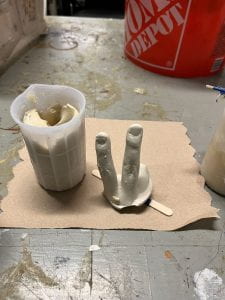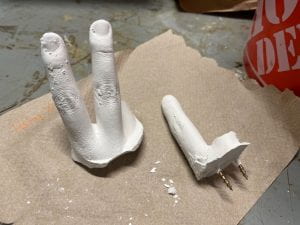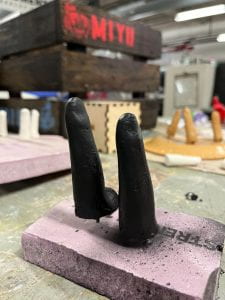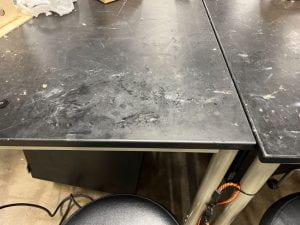For this molding and casting homework, I made two identical copies of my index finger. I used a 1:1 alginate to water volume ratio for my mold. Once it was fully mixed, I stuck my two fingers in for about 5 minutes until the mold turned solid. Then, I prepared a 2:1 plaster to water volume ratio, stirred it until a viscous-liquidy consistency, and poured it into my mold. Lastly, I inserted screws into each of my fingers and held them in place by taping the end of the screws onto a popsicle stick. After leaving the plaster mixture in the mold for a night, it was solidified and ready to be pulled out.

My first cast was successful and the mold was still in good condition so I was able to reuse it for my second replica. I repeated the procedure I did for my first casting. However, when I pulled the fingers from the mold, my middle finger broke in the mold and was stuck. So, to make two identical fingers, I have to break the original piece (that looks like this ✌️) in half to match my other index finger cast. But… unfortunately, while I was trying to break in between the two fingers, the index finger broke from the screw head and I have already thrown away the mold.


I made a new mold with the only index finger I have successfully cast. The cast was successful this time. However, because I made the mold with the casted finger instead of my real finger (so it would be identical), the mold did not hold as many details as it would with molding a real finger.

For post-processing, I sanded some rough surfaces slightly while being careful not to sand off my fingerprint details. Last, I spray-painted my fingers with black paint. The results turned out pretty cool and I would like to use them as my hanger.

Cost analysis:
- Labor: $15/hr x 2hr = $30
- Material:
- Alginate: $10/4lb x 0.1lb = $0.25
- Plaster: $8/4lb x 0.1lb = $0.2
- Black spray paint: $4.64/12oz x 1oz = $0.37
- Popsicle sticks: $3/150ct x 5ct = $0.1
- TOTAL: $30.92
Clean workspace:

